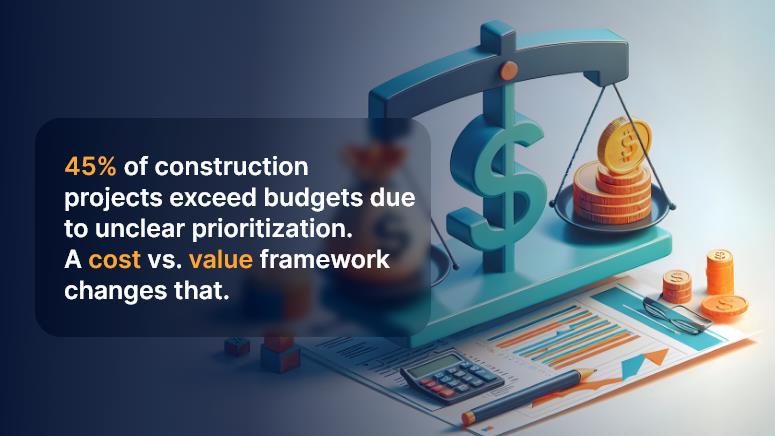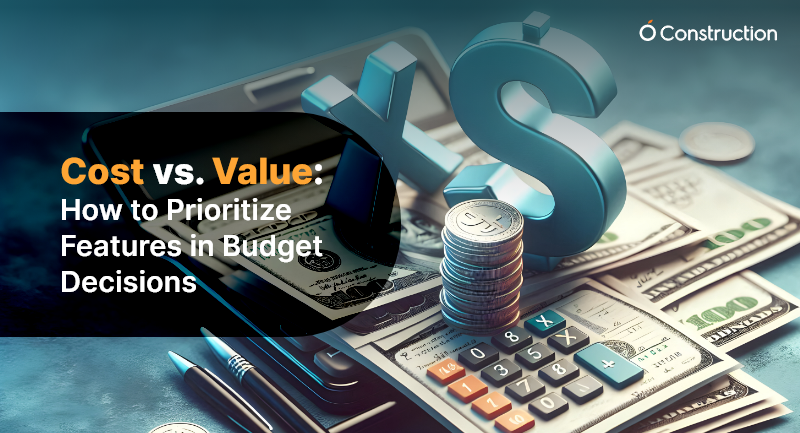When it comes to managing construction projects, one of the hardest choices isn’t just setting the budget—it’s deciding what to prioritize within it. A flashy new feature may look appealing, but will it truly drive value? According to McKinsey, nearly 45% of construction projects exceed their budgets due to poor allocation of resources and unclear prioritization. That’s where cost vs. value in project management becomes essential.
In this blog, we’ll explore how to evaluate features not only based on cost but also on the real value they bring to your business. You’ll learn how to make smarter budget decisions, balance short-term savings with long-term ROI, and see how OConstruction’s integrated project management platform helps you streamline these tough trade-offs.

Business Relevance & Why It Matters
Every construction project has constraints: time, scope, and most importantly, budget. Yet, many teams struggle to align spending with true business value. Choosing features purely on cost often leads to short-lived wins but long-term headaches—while focusing solely on value without considering budget constraints can derail profitability.
Why Companies Should Care:
- Executives need clear ROI visibility to justify investments to stakeholders.
- Project managers require tools to allocate budgets efficiently and avoid feature overload.
- Clients & developers want confidence that every dollar spent translates to tangible project outcomes.
Common Challenges Without a Cost vs. Value Approach:
- Over-investing in underused features that inflate costs.
- Neglecting critical tools (like risk tracking or time management) that save money in the long run.
- Struggling to demonstrate ROI when negotiating budgets or pitching to clients.
The cost vs. value in the project management framework provides a lens to assess priorities based on both immediate affordability and long-term benefits. When supported by digital platforms like OConstruction, businesses gain real-time insights into cost allocation, usage patterns, and ROI forecasting. The result? Better decisions, leaner budgets, and higher client satisfaction.
Best Practices, Frameworks, and Actionable Strategies
Dos for Balancing Cost vs. Value in Project Management
- Quantify Value Beyond Cost
Don’t just look at upfront pricing. Evaluate features on long-term savings, efficiency gains, and improved client relationships. For instance, a robust time-tracking tool might cost more, but it can prevent budget overruns.
- Prioritize Must-Have Features First
Start by identifying critical features that directly impact project delivery (e.g., task scheduling, client reporting, and risk tracking). OConstruction lets you categorize features by “must-have,” “nice-to-have,” and “optional,” ensuring essentials come first.
- Involve Stakeholders in Decision-Making
Different stakeholders view value differently. Executives may focus on ROI, while project managers may value automation. Use collaboration dashboards to gather diverse inputs before finalizing.
- Apply a Weighted Scoring Framework
Score features by cost, business impact, and urgency. This structured method ensures decisions aren’t swayed by emotions or trends.
Don’ts in Feature Prioritization
- Don’t Overload Teams with Unnecessary Features
More isn’t always better. Too many features can confuse users, leading to low adoption and wasted budgets.
- Don’t Undervalue Integration
Buying a cheap standalone tool may save in the short term, but creates silos later. Integrated platforms like OConstruction deliver long-term value through seamless workflows.
- Don’t Ignore Future Growth
A feature that seems excessive now might be essential as your business scales. Avoid tunnel vision by considering scalability
Quick Wins & Best Practices
- Start Small, Scale Later: Invest in core features now, then expand as ROI proves itself.
- Use Data-Driven Insights: Leverage usage reports to see which tools add the most value.
- Revisit Priorities Quarterly: Business needs evolve, so should your feature priorities.
Step-by-Step Framework: Balancing Cost vs. Value
- Identify Needs: List all potential features with input from stakeholders.
- Estimate Costs: Get upfront and long-term pricing for each feature.
- Measure Value: Score each feature’s impact on efficiency, client satisfaction, and risk reduction.
- Rank & Prioritize: Apply a weighted scoring system to align with goals.
- Decide & Implement: Start with high-value, essential features.
- Review & Adjust: Track ROI quarterly and reprioritize as needed.
Customer Story
For example, Skyline Developers, a mid-sized construction firm, struggled with ballooning budgets due to underutilized software features. They were paying for advanced analytics and AI forecasting, but lacked adoption among teams.
After adopting OConstruction, they implemented the cost vs. value in the project management framework. Using the platform’s built-in scoring tools and ROI dashboards, Skyline prioritized essential features like time tracking, task management, and real-time collaboration. They postponed non-critical add-ons until adoption improved.
The results:
- Project delivery improved by 30% due to better scheduling.
- Software costs were reduced by 20% after cutting unused features.
- Client satisfaction rose significantly thanks to transparent reporting.
This cost vs. value approach helped Skyline balance budgets, improve outcomes, and build stronger trust with stakeholders.
Key Takeaways
Balancing cost vs. value in project management is about more than numbers—it’s about making strategic choices that maximize ROI, minimize waste, and deliver real impact.
Key Takeaways:
- Start with essentials. Focus on must-have features that directly influence project outcomes.
- Use data, not guesswork. Measure feature adoption and ROI continuously.
- Think long-term. Value extends beyond cost, especially when scaling.
In today’s competitive construction landscape, companies that prioritize value-driven budgeting not only save money but also strengthen client trust and deliver projects on time. By leveraging digital tools like OConstruction, you can turn budget decisions into a growth strategy.
Frequently Asked Questions
1. What does cost vs. value mean in project management?
Cost vs. value in project management refers to weighing the price of a feature, tool, or resource against the long-term benefits it delivers. Instead of focusing only on upfront costs, teams consider ROI, efficiency gains, and scalability when making budget decisions.
2. Why is cost vs. value important in construction project budget planning?
Construction projects often face tight budgets and high stakeholder expectations. Without a cost vs. value approach, teams risk overspending on underused features or neglecting critical tools. Prioritizing based on value ensures budgets drive measurable project outcomes.
3. How can project managers prioritize features effectively?
Project managers can use a weighted scoring framework that evaluates features on cost, business impact, and urgency. This structured method helps avoid emotional or trend-driven decisions and ensures investments align with project goals.
4. What are common mistakes when prioritizing features in construction projects?
The most common mistakes include:
- Overloading teams with unnecessary features.
- Ignoring integration between tools.
- Focusing only on upfront costs without considering long-term ROI.
- Overlooking scalability for future growth.
5. How does software like OConstruction help in balancing cost vs. value?
OConstruction provides built-in scoring tools, ROI dashboards, and real-time usage reports. These features help teams categorize must-have vs. nice-to-have features, track adoption, and reprioritize budgets quarterly to stay aligned with business needs.
6. What role do stakeholders play in feature prioritization?
Executives, project managers, clients, and developers each view value differently. Involving all stakeholders ensures that decisions reflect diverse needs—ROI for executives, automation for managers, and usability for teams—leading to smarter budget allocation.
7. Can cost vs. value decisions improve client satisfaction?
Yes. When budgets are allocated to features that directly improve project delivery—like time tracking, risk management, and transparent reporting—clients see faster results, fewer overruns, and clearer ROI, which builds trust and long-term relationships.
